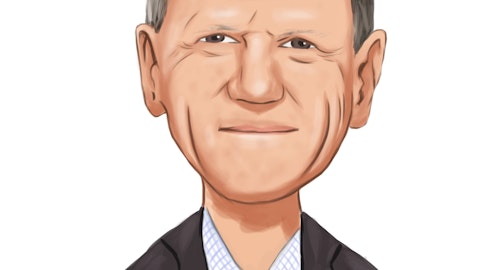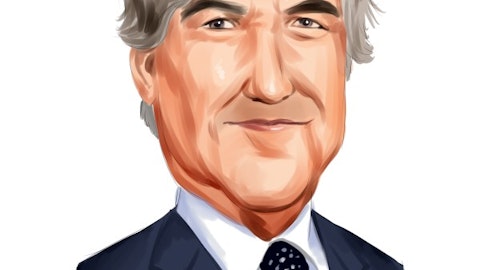Golub Capital BDC, Inc. (NASDAQ:GBDC) Q4 2022 Earnings Call Transcript November 23, 2022
Operator: Hello everyone and welcome to GBDC’s September 30, 2022 Quarterly Earnings Call. Before we begin, I’d like to take a moment to remind our listeners that remarks made during this call may contain forward-looking statements within the meaning of the Private Securities Litigation Reform Act of 1995. Statements other than statements of historical facts made during this call may constitute forward-looking statements and are not guarantees of future performance or results and involve a number of risks and uncertainties. Actual results may differ materially from those in the forward-looking statements as a result of a number of factors, including those described from time-to-time in GBDC’s SEC filings. For materials we intend to refer to on today’s earnings call, please visit the Investor Resources tab on the home page of our website, which is www.golubcapitalbdc.com and click on the Events Presentations link.
Our earnings release is also available on our website in the Investor Resources section. As a reminder, this call is being recorded. With that, I’m pleased to turn the call over to David Golub, Chief Executive Officer of GBDC.

Photo by Austin Distel on Unsplash
David Golub: Hello everybody, and thanks for joining us today. I’m joined by Chris Ericson, our Chief Financial Officer. We also have a couple of new participants today: Matt Benton, who was recently promoted to a new role as Chief Operating Officer of GBDC, please join me in congratulating him, and Greg Cashman, who heads Golub Capital’s Direct Lending Group. For those of you who are new to GBDC, our investment strategy is, and since inception it’s been to focus on providing first lien senior secured loans to healthy resilient middle market companies that are backed by strong partnership oriented private equity sponsors. Yesterday, we issued our earnings press release for the quarter and for the fiscal year ended September 30, 2022, and we posted an earnings presentation on our website.
We’ll be referring to this presentation during the call today. One element of Golub Capital’s culture is what we call raise the bar exercises. These are efforts on our part to improve how we do things. Today, we’re going to introduce a new format for our earnings calls that came out of one of our raise the bar exercises. We’re going to cover five topics. First, I’ll discuss highlights of GBDC’s performance for the quarter and for the fiscal year ended September 30. Second, I’ll talk about the macro environment what we’re seeing in the economy and what we think this means for GBDC. Third, Greg Cashman will give us some real time market insight on two topics. Think of them as defense and offense. On defense, Greg will talk about the actions Golub Capital has taken and is taking to manage risk in light of the heightened macroeconomic uncertainties we’re all dealing with.
And on offense, Greg will talk about the opportunity set for new investments and why we think it’s quite attractive today. Fourth, we’ll go through financial results for the quarter and for the fiscal year in detail. And finally, I’ll come back to make some closing remarks and take questions. Before we jump in, I also want to mention that we plan to file a new and improved investor presentation over the next two weeks. We plan to file updates to this presentation on a quarterly basis going forward. We hope that you’ll find it to be a useful source of additional information on GBDC and on Golub Capital. So, let me start with highlights for the quarter. The overall headline is that GBDC’s performance was solid and that’s despite a second consecutive quarter marked by sharp downdrafts in debt and equity markets.
The first highlight is that adjusted net investment income was strong. Adjusted NII per share increased by 6% to $0.33 from $0.31 per share in the quarter ended June 30. The increase in adjusted NII per share was driven by higher base rates, continued credit stability, and GBDC’s low cost of funding. That said, we’re not immune to market downdrafts. Primarily as a result of spread widening, GBDC booked some unrealized losses this quarter and that caused NAV per share to decline by 1.7% from $15.14 to $14.89. The good news, as we’ll come back to in a moment, is that credit quality looks very solid from a fundamental perspective. Whenever we have a quarter marked by spread widening, you hear me say the same thing. You hear me say that mark-to-market losses from spread widening, they don’t matter in the long run.
What matters is minimizing permanent or realized losses. If we can avoid realized credit losses, the mark-to-market adjustments reverse over time as borrowers pay off, whereas their credit attributes improve, whereas market spreads narrow. The good news is that we think we’ll see some reversals of mark-to-market losses in future quarters. And there’s even more good news: given rising base rates and spreads, and given GBDC’s funding structure, there’s potential for further increases in NII in coming quarters. We’ll cover this in more detail later in this call, which brings me to a second highlight, dividends. We announced in our press release a 10% increase in GBDC’s quarterly base dividend from $0.30 a share to $0.33 a share, which equates to an 8.9% dividend yield on our 9/30/2022 NAV of $14.89.
Why are we increasing the dividend? Simply put, higher base rates and higher spreads have increased GBDC’s earnings power. On the asset side of the balance sheet, GBDC’s portfolio, which is almost all floating rate loans, it’s generating more interest income due to higher base rates and higher spreads. The forward rate curve tells us rates are likely to go up further from here, and today’s rates and spread widening are not yet fully reflected in this quarter’s earnings due to lag effects. On the liability side of the balance sheet, GBDC has locked in low cost, highly flexible debt capital. About half of GBDC’s debt is in the form of fixed rate unsecured notes and these notes have an average cost of about 2.7%. We believe interest income is likely to increase faster than interest expense in the coming period and this means GBDC’s earnings power is likely to exceed the 8.9% dividend yield GBDC posted in the 9/30 quarter.
We’ll provide more details on this on this call. I’d also note that GBDC is now fully through its catch up for the income incentive fee. This means that as our portfolio continues to reset today’s higher base rates, and as we benefit from further base rate increases, 80% of incremental returns will increase GBDC’s NII. Looking forward, we believe GBDC is well-positioned to generate NII meaningfully in excess of the new quarterly base dividend of $0.33, giving us flexibility in calendar 2023 to consider a further dividend increase and/or potential supplemental or special dividends. The third highlight from the quarter is that GBDC’s credit quality remains strong. As you know, our strategy focuses on investments in resilient companies, in resilient industries, in resilient geographies, and with resilient owners.
We don’t play in highly cyclical or volatile areas like energy or crypto or real estate or aviation. And so far the data shows our strategy is working. I’ll share a few highlights now, which we’ll come back to a bit later in the session. Realized losses for the quarter and for the fiscal year were once again low and were more than completely offset by realized gains. For the quarter, we had just less than $1 million of realized losses versus $4 million of realized gains. For the fiscal year, we had just $2.5 million of realized losses versus realized gains of $21.4 million. Over 90% of investments in GBDC’s portfolio had an internal performance rating of 4 or higher as of September 30. This is a level consistent with our loan performance ratings pre-COVID, and the percentage of investments on non-accrual measured at fair value also remained low at just 1.3% of our portfolio.
The fourth and final highlight: GBDC is well-positioned for the uncertainties we’re all facing in the coming period. This is not our first rodeo. Historically, we’ve navigated difficult periods well. In fact, difficult periods have tended to be good for our business and good for our investors. We’ve curated GBDC’s portfolio to be resilient to interest rate risk and to credit risk. More than 90% of the portfolio consists of floating rate first lien, first out senior secured loans to what we believe to be resilient companies backed by private equity sponsors with whom we have deep and long standing relationships. GBDC has a highly flexible and durable funding structure with ample liquidity. 47% of its debt funding is in the form of unsecured, longer dated, unsecured notes and that’s complemented by a $1.2 billion corporate revolver with undrawn capacity and that’s materially over collateralized.
Because GBDC is defensively positioned, it’s also very well suited to play offense in what’s become a very attractive new origination environment. We’ll go into more detail about our outlook for originations later in the presentation. In short, we believe GBDC’s results for both the quarter and the fiscal year were solid. Now, let’s take a step back, look at the macro picture and unpack what it means for GBDC. As you know, Golub Capital has a unique perspective on the economy. We lend to hundreds of middle market companies, we receive monthly financials from many of them, we’re in constant dialogue with a host of smart private equity firms and management teams. So, we’re getting actual results and insight on the portion of the economy we lend to almost in real time.
What we’re seeing is the economy is muddling through. It’s not booming like it was a year ago, but it’s muddling along with real growth. Companies are able to keep their revenues up and for the most part they’re increasing prices directionally with inflation. Margins are down a bit, that’s a topic we’ll come back to, but from our vantage point, consumers are spending and businesses are doing pretty well. The big question is, where to from here? We’re in a confusing environment. It’s marked by conflicting vectors and an unusually wide range of possible scenarios. There are a number of vectors that point in a negative direction, including high inflation, rising rates, quantitative tightening, declining fiscal stimulus, worsening consumer sentiment, and there’s the wealth effects from the recent sharp losses in both equity and debt markets.
But there are also vectors that point in a positive direction. We have very low unemployment, generally healthy consumer balance sheets, corporate profits which are still strong despite some recent signs of slowing growth, and low inventories in most durable goods sectors largely as a consequence of supply chain issues. So, in short, we’ve got a bunch of forces that are pulling in different directions right now. And it’s all happening against the backdrop of a disrupted international environment. There’s the war in Ukraine. There’s tension between Russia and the West. There’s tension between the U.S. and China. There’s tension in multiple democracies between right and left factions, and there’s still concern about Iran and North Korea to name a few.
So, back to the big question, where to from here? I don’t think anybody knows. If you’re looking for a historical parallel, if you want to say, Well, 2023 is going to be just like I don’t think that you’re going to find a good one. I don’t think we’ve seen this combination of vectors before. Now and looking at it, we think muddling growth is the most likely scenario for the near future, but there’s a range of possible alternative scenarios. So, what does this mean for GBDC? We think it’s prudent to manage GBDC in this environment such that it’s going to perform well if we’re right about muddling growth. And we want it to be resilient in case the unexpected happens. I’m going to pass the mic to Greg Cashman, Head of Direct Lending at Golub Capital, to say more about how we’re playing defense and offense with this macro perspective in mind.
Greg Cashman: Thanks David. I’m going to focus first on how we’re managing risk in today’s environment. I’ll talk about what we are seeing today, what we are doing differently, and what we aren’t doing differently. And I’ll talk about what we’re seeing in terms of new investment opportunities. Let’s start with what we’re seeing today. As David mentioned, GBDC’s credit quality generally remains strong. Realized losses and non-accruals have been low, while internal performance ratings have been comparable to pre-COVID levels. Those are some of the quantitative ways we look at credit performance. We also assess how we’re doing on credit with a qualitative lens based on what we see and hear from sponsors and management teams. And what we’re seeing today is that our borrowers generally fall into one of three buckets.
Most are performing well and seeing growing profits. Then there’s a smaller group of borrowers that are growing a bit slower than expected, but still doing okay. And finally, there’s a group that’s seeing falling profits due to margin pressure, usually due to wage pressures, rising input costs or both. When we talk to sponsors and CEOs of companies in that last group, they typically tell us that they just raise prices or they plan to raise prices shortly. Will those price increases stick? And if they do, will they be enough to offset rising costs? Well, in most cases, they probably will, because we seek to invest in market leaders that we believe are resilient to inflation. But the reality is, it’s too soon to tell. So, let’s shift and talk about how we’re managing risk in-light of what we’re seeing in the macro environment.
Let me start with what we aren’t doing differently. We continue to focus on lending to resilient companies in resilient industries in resilient geographies and with resilient owners. We’re not involved in interest rate sensitive industries like homebuilders or heavily cyclical or capital-intensive industries like E&P and real estate. Our focus is on defensive businesses with strong free cash flow profiles that will do well in a wide variety of different economic climates, even when we’re not feeling very optimistic about the future. What are we doing differently? We think that we’re good at what we do, but we also know that we’re not perfect. So, we’re looking hard right now for potential areas of weakness. This isn’t different in and of itself.
Identifying problems early has always been a key part of our portfolio management. What I want to highlight is that we’ve enhanced our credit monitoring screen with a view towards identifying tail risks on a granular, bottom-up, company by company basis. We’re looking hard at five key factors. First, interest rates. We’re looking for borrowers who may have potential liquidity or cash flow issues from increased base rates. Second, inflation. We’re looking for companies susceptible to contracting operating margins. This means looking closely at cost drivers and pricing power. I mentioned earlier that not every price increase that companies try to push through will stick. So, we’re focusing on cases where pricing power may have hit a limit. Third, recession resistance.
Some companies are more susceptible to recessions than others. In particular, we’re working to identify companies with material risk of falling revenues. Fourth, international exposure. We’re looking for companies with material exposure to U.S. dollar fluctuations or to customers or suppliers in areas of geopolitical tension or economic weakness. And fifth, quality of earnings. We’re looking at credits with high levels of EBITDA adjustments that may not be realized in practice. The goal of our enhanced credit monitoring today is to find higher-risk borrowers and allocate more resources to them, much as we did in March 2020. That covers how we’re thinking about risk. Now, I want to talk about opportunity. In short, overall deal activity is down and it is a highly attractive origination environment.
Why is market wide deal activity lower? Well, we’ve just been through an equity market downdraft and buyers and sellers can agree on value in a climate like this, sellers want the price they could have gotten three months ago or six months ago, buyers don’t want to pay it. The good news for us is that our 300+ incumbencies give us a robust access to opportunity even when the new deal market is slow. A lot of our sponsor clients see dislocations like the present one as great opportunities to grow their platforms with accretive add-ons. This means they need more capital and the logical party that they want to go to first is their incumbent lender. In the case of hundreds of borrowers, that’s us. In these cases, we know the company, we know the management team, and we know the sponsor.
We’ve seen how they perform. And we don’t need to negotiate a whole new credit agreement to give them the capital they need. During periods of slower M&A activity, we typically see an increase in the proportion of origination that comes from repeat borrowers. As a benchmark, about half of our origination volume over the last several years has come from repeat borrowers. That proportion is increasing markedly and we expect it to remain elevated for the rest of 2022 and into 2023. And we think these add-on opportunities are particularly attractive. The market is the most lender friendly that it’s been in recent years. Spreads have widened by 50 basis points to 100 basis points, leverage has gone down half to a full turn, and documentation terms are tighter, especially in areas we care a lot about like the definition of EBITDA.
As a result, we believe the opportunity set in our areas of focus is among the most attractive since the great financial crisis. With that, I’m going to turn it over to Chris Ericson to go through GBDC’s results for the quarter and fiscal year in more detail.
Chris Ericson: Thanks, Greg. Let’s turn to Slide 4, which summarizes our results for the quarter compared to the prior quarter. GBDC’s adjusted NII per share increased by $0.02 quarter-over-quarter to $0.33 per share. GBDC had an adjusted net realized and unrealized loss per share of $0.28, primarily from unrealized depreciation due to spread widening. Adjusted EPS was $0.05 per share, and we view this as a solid performance in the context of the downdraft in debt and equity markets during the quarter. Moving to Slide 7. This slide provides the bridge from GBDC’s NAV per share of $15.14 as of June 30, which declined slightly by 1.7% to a NAV per share of $14.89 as of September 30. Let’s walk through the components. As I just mentioned, adjusted NII was $0.33 per share and the company paid $0.30 per share of dividends.
Adjusted NII was offset by a loss of $0.28 per share from the net change in unrealized appreciation and depreciation on investments. In our view, these unrealized losses were driven primarily by spread widening in the market rather than fundamental credit issues. And finally, net realized appreciation and depreciation came to a gain of $0.01 per share. Slide 10 summarizes our origination activity for the quarter. Net funds growth declined quarter-over-quarter and there were two key drivers: one, exits and sales of investments outpaced new originations in the September 30 quarter; and the second, fair value adjustments on existing investments due to unrealized depreciation also contributed to the negative net funds growth. The asset mix, shown in the middle of the slide, remained fairly constant with our prior quarter originations.
Looking at the bottom of the slide, the weighted average rate on new investments increased by 120 basis points this quarter from a combination of higher base interest rates, as well as wider asset spreads on new originations. The weighted average spreads on new investments increased by 40 basis points over the prior quarter from 5.8% to 6.2%. We believe the combination of higher benchmark rates and increasing asset spreads creates a foundation for further increased returns at GBDC in future periods. Slide 11 shows GBDC’s overall portfolio mix. As you can see, the portfolio breakdown by investment type remained consistent quarter-over-quarter, with one-stop loans continuing to represent around 85% of the portfolio at fair value. Slide 12 shows that GBDC’s portfolio remained highly diversified by obligor, with an average investment size of approximately 30 basis points.
As of September 30, 94% of our investment portfolio was comprised of first lien senior secured floating rate loans and defensively positioned in what we believe to be resilient industries. I’ll now turn the floor over to Matt.
See also 12 Safest Stocks To Invest In and 11 Best Micro-cap Dividend Stocks To Buy.
Matt Benton: Thanks, Chris. Let’s turn to Slide 13. One general point is that the rising interest rate environment really highlights the asset sensitive nature of GBDC’s balance sheet. I’ll come back to the theme in more detail on the next slide. But looking at the data on Slide 13, let’s start with the dark blue line, which is our investment income. As a reminder, investment income includes the amortization of fees and discounts. GBDC’s investment income increased by 170 basis points, primarily from a combination of rising interest rates and accelerated discount amortization from higher payoffs compared to last quarter. By contrast, our cost of debt, the teal line, increased only 70 basis points. Our cost of debt benefits meaningfully from our approximately $1.5 billion of unsecured notes that are fixed rate and have a weighted average coupon of 2.7%.
Combining these two factors, our weighted average net investment spread, the green line, increased by 100 basis points over the prior quarter. Note that the increase in GBDC’s net investment spread, combined with GBDC’s current GAAP leverage of 1.22x debt-to-equity, have pushed GBDC fully through the catch-up period on the income incentive fee. This implies that further increases to our weighted average net investment spread from higher base rates will increase NII. Now, let’s drill down on this point. On Slide 14, we’ve quantified the potential positive impact of higher base rates on GBDC’s NII earnings power. The key takeaway is that GBDC’s adjusted NII per share stands to benefit substantially from two key tailwinds in the coming period.
The first tailwind is that there’s a lag between when base rates change in the market and when loans in our portfolio reset to higher base rates, which happens once per quarter in most cases. Said another way, GBDC has about a quarter lag effect in its portfolio. The chart on this slide is our attempt to help demystify this dynamic for you. In other words, the average LIBOR or SOFR rate GBDC actually earned on its investments for the quarter ended 9/30 was meaningfully less than the market rates as of 9/30. The second tailwind is that base rates look likely to increase further from 9/30 levels based on the interest rate forward curve. Now these tailwinds will be offset to an extent as GBDC’s floating rate liabilities also reset to higher base rates, but crucially, this dynamic only applies to the 53% of GBDC’s debt stack that’s floating rate.
Said another way, GBDC’s floating rate liabilities represent less than 30% of GBDC’s total funding when you also include its equity capital. Consider that 95% of its total investment portfolio, including equities, is floating rate. To try to quantify the potential benefit of these tailwinds, Slide 14 shows our estimates of GBDC’s adjusted NII per share under two hypothetical scenarios. Now, let me describe how to read this chart. The leftmost bar shows GBDC’s actual adjusted NII of $0.33 per share for the quarter ended 9/30. On average for the quarter, the average LIBOR rate was approximately 300 basis points. The middle bar looks at what GBDC’s adjusted NII per share would have been in the 9/30 quarter if all of its floating rate assets and liabilities had been based on the LIBOR rate of 375 basis points, the rate at quarter-end.
In this scenario, all else equal, we estimate adjusted NII would have increased 12% to $0.37 per share. The right bar goes a step further and looks at what adjusted NII per share would have been if LIBOR had been even higher, 475 basis points, an increase of 100 basis points from actual quarter-end LIBOR. We think this is a realistic scenario given three-month LIBOR is currently above 460 basis points and is projected to go above 5% by January of next year. In other words, this scenario shows both the lag effect and the higher rates we expect in the future. All else equal, we estimate adjusted NII would have increased 24% to $0.41 per share. The bottom line is that we think GBDC’s NII per share has a lot of built-in momentum just from higher LIBOR rates that have already occurred, but have not yet flowed through GBDC’s results.
We aren’t assuming net funds growth, we aren’t assuming wider spreads on existing investments, for example, from amendment activity or increased payoffs or non-accruals. In our view, those are possible drivers of further NII upside. You’ll see additional detail on GBDC’s asset sensitivity in the Form 10-K if you’d like to drill down further. Now, let’s move to Slides 15 and 16 and take a closer look at credit quality metrics. On Slide 15, you can see that the number of non-accrual investments as of 9/30 remain the same at eight investments compared to 6/30. This is because the disposition of one non-accrual investment was offset by the addition of one new non-accrual investment. In addition, one of these eight non-accrual investments was disposed of after quarter-end for proceeds slightly higher than fair value as of 9/30.
On Slide 16, as David mentioned earlier, internal performance ratings have been strong and stable. Over 90% of investments have an internal performance rating of 4 or higher, which means they are performing as expected or better than expected at underwriting. And only 1.3% of investments have an internal performance rating of 2 or lower, which means they are performing materially below expectations at underwriting. We’re going to skip past slides 17 through 21. These slides have more detail on GBDC’s financial statements, dividend history, and other key metrics. The last slide I want to cover before handing it back to David is Slide 22. We believe GBDC has meaningful value embedded in its funding structure. Our stable, flexible, and low-cost funding structure helps us play offense in the attractive environment for new investments that Greg described earlier.
We ended the quarter with almost 800 million of dry powder from unrestricted cash, undrawn commitments on our meaningfully over collateralized corporate revolver and the unused unsecured revolver provided by our advisor. Our GAAP debt-to-equity ratio as of 9/30, net of unrestricted cash, was 1.17x. 47% of our debt funding is in the form of unsecured notes, the majority of which have maturities in 2026 and 2027. We issued these fixed rate notes with a weighted average coupon of 2.7% and did not swap these out to floating rate. Our weighted average cost of debt for the quarter ended September 30 was 3.7%, which we believe is among the lowest in our peer group of publicly traded BDCs. We believe our funding structure is a meaningful competitive advantage and will continue to be one for us.
I’ll turn it back over to David for closing remarks and Q&A.
David Golub: Thanks, Matt. To sum up, GBDC’s performance for the quarter and for the fiscal year ended September 30 was solid. Net interest income benefited from higher base rates and higher spreads, and both are likely to go up further. Credit quality remained strong, realized losses remained low, and we announced an increase in GBDC’s dividend and we indicated that we believe the company could expect to consider a further increase in the future. With that, let me open the line for questions.
Q&A Session
Follow Golub Capital Bdc Inc. (NASDAQ:GBDC)
Follow Golub Capital Bdc Inc. (NASDAQ:GBDC)
Operator: Our first question will come from the line of Finian O’Shea with Wells Fargo Securities. Please go ahead.
Jordan Wathen: Hi, good morning. This is actually Jordan Wathen for Fin today. Appreciate the disclosure hey, good afternoon. Appreciate the disclosure on NOI upside from rising rates. I was just curious and maybe you could give us some context on how rising rates might impact the interest coverage of your borrowers, understanding that maybe that’s not relevant for some of the recurring revenue loans, but maybe the larger portfolio as a whole?
David Golub: Look, we’ve got a number of headwinds that are impacting borrowers in the coming months. One source of headwinds is a slowing economy. And we talked some about that in our prepared remarks. A second source of headwinds is higher base rates. Now, there are as many different stories here as there are different borrowers in some of the discussions that we’ve been having with investors recently. I’ve been making the, I think, really the important point that average interest coverage ratios aren’t really very informative. We as lenders, we don’t lose money on our average credits. We lose money on the tail. We lose money on our worst credits. And that’s why I thought what Greg Cashman talked about in today’s call is so important.
What we think we need to be doing right now on the defense side is undertaking a granular, bottoms up review of all of our loans in order to identify the ones that are most vulnerable. Part of that vulnerability, Jordan, is the impact of rising rates. There are other sources of issues for borrowers as well in today’s environment. I think that granular focus is the right way to protect the portfolio. I don’t think there’s a lot of conclusion that we’re going to be able to draw by looking at interest coverage ratios in and of themselves. Let me give you another example of why I think interest coverage ratios are problematic. One of the largest sources of friction in investment committee discussions and discussions with sponsors over the last couple of years has been EBITDA adjustments.
When folks calculate interest coverage, they’re generally not using cash EBITDA, they’re using an adjusted EBITDA. And you can’t buy beer with adjustments. So, again, if credit was easy, if everything could be reduced to a set of formulas and ratios, I guess it’d be bad for our business because it would mean investors don’t need us to make credit judgments. I don’t think it is easy. I think credit is very difficult and something that requires a great deal of judgment. I think this is an area that illustrates the point. Interest coverage is going to be something that we’re all going to need to look at prospectively on a credit by credit basis in the context of how the company is doing? Is it growing? Is it not growing? What kind of cash taxes, what kind of CapEx, what kind of other uses of cash are important for that company?
I’m sorry if I sound passionate on this, but I’m frustrated with the degree of focus on one ratio. I don’t think it tells us much.
Jordan Wathen: No, I appreciate that. And so, maybe just ask a different way. Have you seen any uptick in amendments recently and amendment requests? And would you characterize them as being, you know, forward looking? Maybe a little worried about where their interest costs are going over the next say 6 to 12 months?





